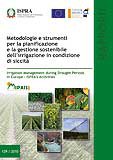Methodological tools for sustainable planning and management of irrigation in drought conditions. Irrigation Management During Drought Periods in Europe - ISPRA's Activities
ISPRA has participated as a partner in the project MIPAIS - “Méthodologies et Instruments pour la Planification et la gestion durable de l´Irrigation en condition de Sécheresse” from April 2005 to October 2007, within the context of the Community Initiative Programme of the European Commission Interreg III B. The reduction of meteorical inputs, the different distribution of events and their increasing intensity in the Mediterranean area call for the application of conscious choices, and sometimes aimed at the enhancement and protection of water resources through the adoption of services related to efficient and effective irrigation. The MIPAIS project aims to test the methodologies that allow the sustainable management of irrigation in drought conditions, applied in different representative areas of the Mediterranean basin.
This report describes the work carried out by ISPRA for the MIPAIS project. In particular, the most significant activities have focused on studies concerning the limitation of water demand and the management of irrigation during periods of drought in Europe, particularly in the Mediterranean countries.
The first part of the report gives an overview of the situation in Europe, particularly in the Mediterranean countries, concerning the use of water in irrigation focused on times of drought and on appropriate irrigation technologies.
In addition, the report presents an overview of the irrigation, the water scarcity and the vulnerability to the cycle of drought in Italy, the Italian experience in drought monitoring and risk management and the protection of water quantity and quality.
The second part shows the databases available ISPRA with reference to specific and necessary parameters or indexes for drought monitoring. Information concerning the various phases of the hydrological cycle and drought cycle, in accordance with the literature. All tests have been developed taking into account the reference structure and the need to locate and integrate these results with other information.

